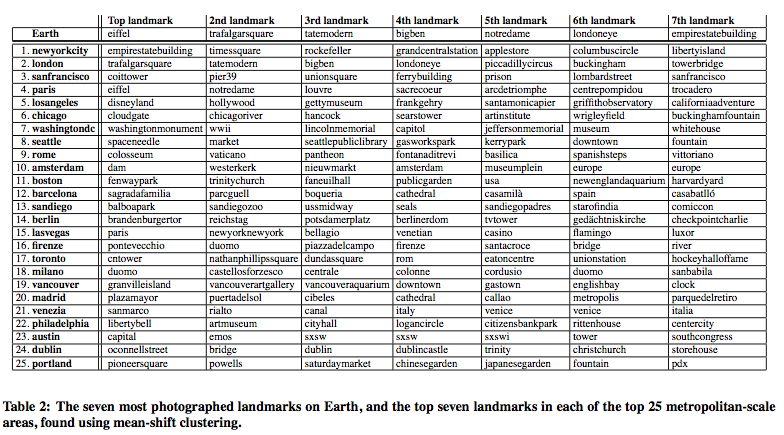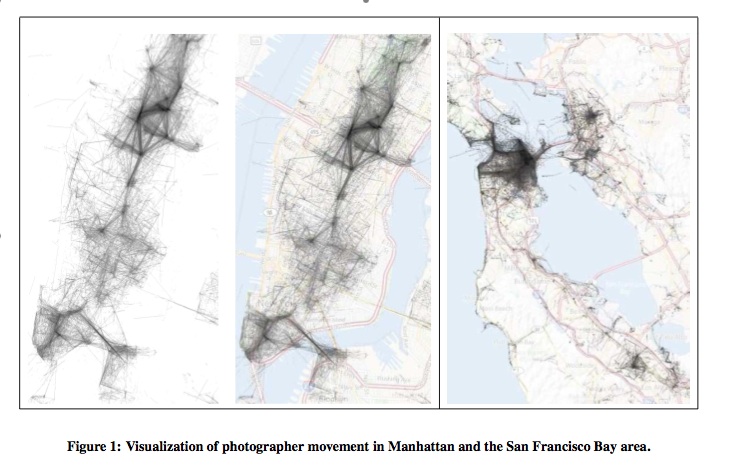The hottest web meme of the past two days -- in urbanist circles at least (I shudder to think of what the hottest overall meme is) -- is the chart of the most photographed cities and landmarks in the world. Last year a team of Cornell researchers assumed the guise of part Web trawlers and part econometricians and, with the help of photo-analysis software, identified every photo on the Flickr photo-sharing site that could recognizably be associated with a city. It ranked the top twenty-five cities and then the top seven most commonly photographed subjects in each.

Not surprisingly, Europe wins the prize for the most photogenic landmarks worldwide. The Eiffel Tower, Trafalgar Square, the Tate Modern, Big Ben, and Notre Dame cathedral round out the top five, although New York ranks first overall among cities. But not far down the grid an astounding pattern emerges: three of the top 25 most photographed cities are in California: San Francisco (third), Los Angeles (seventh), and Lee Vining (13th). Just kidding; 13th goes to San Diego.
This study [pdf] does not suggest that these are the absolute most popular (or at least photogenic) places in the world, since anything that uses Flickr as a dataset is bound to be rife with bias. Most notably, the data is biased towards those who have web access and, moreover, have the savvy or sense of exhibitionism to use Flickr. The demographic traits of that population surely look nothing like that of the world as a whole, and they are in fact likely to be biased towards the very cities that make the top of the list. Flickr itself is a subsidiary of Yahoo!, which is, naturally, based near San Francisco, so the study may say more about the respective cities' tech savvy than their aesthetic appeal.
Though the study seems to have more to do with the web than with cities per se, it has the unfortunate indirect effect of celebrating landmarks over streetscapes and, indeed, icons over places. I like San Francisco's Union Square (SF #3) and adore the Santa Monica Pier (LA #5), but I don't even know what it would mean to "go" to the Hollywood Sign (LA #2) and I'm not quire sure what to do about "seals" in San Diego (#4). Most disturbing to those who believe in California urbanism, some of the state's top scorers aren't so much places as they are artificial attractions: Disneyland (LA #1), Coit Tower (SF #1), and -- brace yourself -- Comicon (SD #7), which isn't even a place so much as a universe all its own.
California's notoriety is heartening, and the study suggests that if all else fails the state can still count on revenue from tourists (and comic book aficionados). But the study ignores that which California so desperately needs: genuine, attractive, liveable places. Tourists are not so likely to snap photos of Old Town Pasadena or of the dozens of main streets in the Central Valley, but those are the places that need the most attention and, ultimately, will generate the most economic activity as they enable Californians to mingle with each other. The best places are, in short, those that don't stand out. California needs ordinary places that evade the shutter not because they are unattractive but because they they are so intertwined in the fabric of residents' lives that they cease to seem special at all.
Indeed, urban planners should (and probably do) know better than anyone else in California that "special" is not the same thing as "spectacle." We now have scientific proof that California has plenty of the latter; our challenge is to build more of the former.
-- Josh Stephens
PS. Far more fascinating, and less predictable, than the ranking of discrete sights are the activity maps that the researchers extrapolated from the aggregate data:

